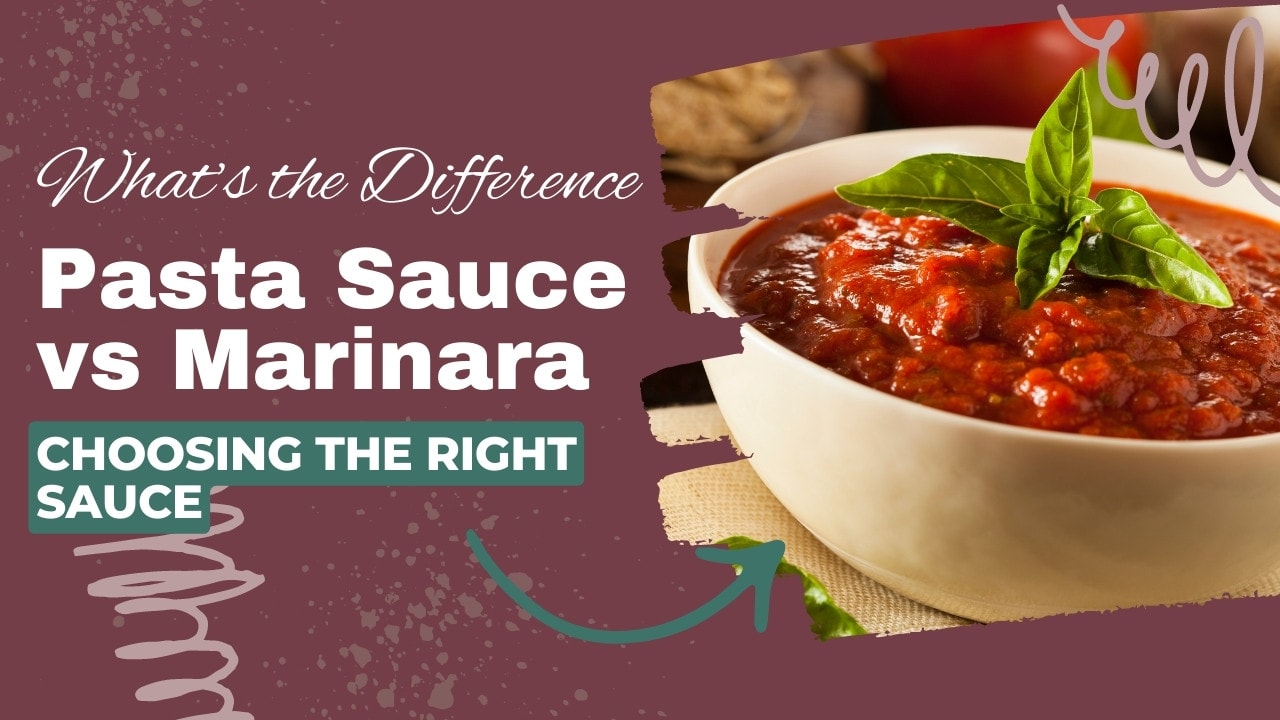Wondering about the similarities and differences between marinara and pasta sauce? Sure, they are both tomato-based sauces that burst with Mediterranean flavors. But that’s about all they have in common.
If you know the nuances of these sauces, you can elevate your cooking game and create delicious, flavorful dishes.
As someone who’s spent plenty of time tinkering with these two tomato-based sauces, I’d like to clarify the differences, share tips on how to use them to their fullest potential, and offer some advice on how to make your sauces thicker and more flavorful.
What’s the Difference Between Marinara and Pasta Sauce?
Marinara is a traditional Italian sauce with a tomato base and a few simple ingredients. In contrast, pasta sauce is a generic term that may refer to any sauce used with pasta dishes, especially Italian classics such as Bolonegese, pesto, and Alfredo. In the US, “pasta sauce” is used synonymously with “spaghetti sauce.”
Ingredients: Marinara is often seasoned with garlic, onions, and herbs like basil or oregano, while pasta sauce may have more complex flavors and ingredients like mushrooms, peppers, cream, cheese, wine, meat, or sausage.
Texture: While both sauces include tomatoes as a core ingredient, marinara is typically lighter and thinner, but pasta sauce is rich and chunky.
Cook time: Marinara has a shorter cook time since you don’t need to add many ingredients or cook any sort of meat. It also has a much simpler cooking process.
Use: Marinara is best served with pasta or used as a dipping sauce. Pasta sauce works with pasta, lasagna, seafood, or other dishes. That said, feel free to use either sauce as a base for other dishes, like soups or stews, by adding additional ingredients and adjusting the seasoning to fit the recipe.
Health: Marinara has fewer calories and less fat. One cup of marinara sauce contains around 130 calories and 2-4 grams of fat, while the same serving size of spaghetti sauce can contain 280 calories and 16 grams of fat. Of course, the nutritional values vary widely based on the ingredients used in the recipe, and whether it’s store-bought or homemade.
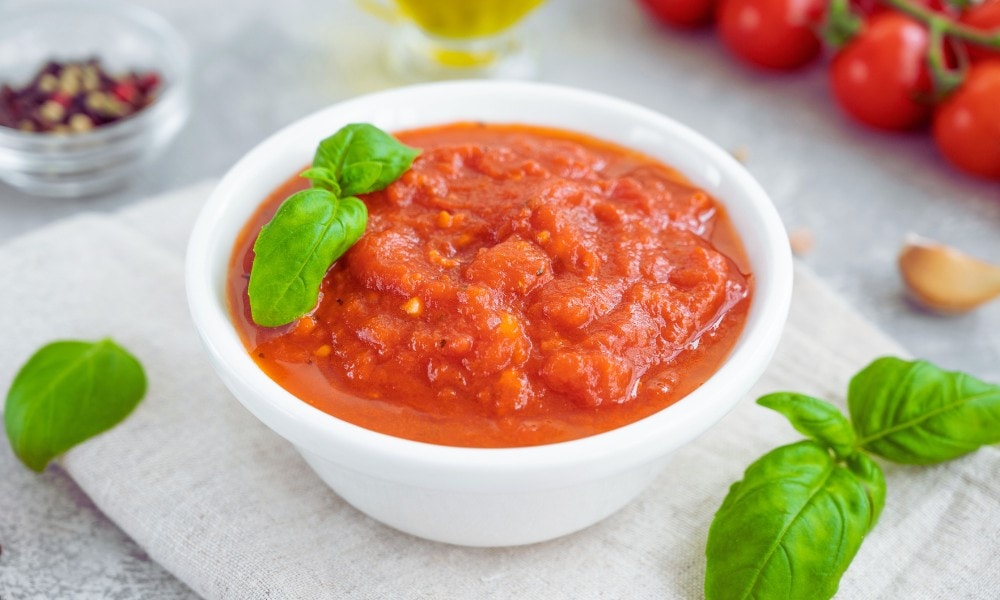
What’s Marinara?
Marinara is a thin tomato-based sauce that typically includes garlic, olive oil, and herbs such as basil, oregano, and thyme. Some sauce recipes also call for onions and tomato paste, which add a chunkier texture and darker color to the sauce.
When it comes to the type of tomato to use, San Marzano tomatoes are the go-to for many chefs as they have a high sugar and pectin content. The sugar gives your sauce a sweet taste, while the pectin gelatinizes the sauce as it breaks down, giving your marinara a thicker consistency.
Cherry and Roma tomatoes also work great for the same reasons. Some chefs like to use multiple types of plum tomatoes to combine different tastes and textures.
My favorite way to make marinara is to cut a few cherry tomatoes in half and caramelize them on low heat in a base of herbs, garlic, and olive oil. Then I add a can of crushed San Marzanos to the sauce pan and let the mixture simmer for about 30 mins. The result is a rich and flavorful sauce with a hint of sweetness that’s perfect for your favorite type of pasta.
Pro tip: The traditional marinara sauce has tomato chunks, but if you want a smooth sauce, you can pulse your marinara with an immersion blender.
What’s Pasta Sauce?
Unlike marinara, pasta sauce or spaghetti sauce isn’t a specific sauce with a strict recipe. Many people use it as a generic term to refer to the classic Italian sauce called bolognese or its American variations.
Pasta sauce is a rich and hearty tomato-based sauce that may contain ground beef, pork, lamb, Italian sausage, or a combination of these meats. Some people use lean meat such as ground chicken or turkey, but the sauce won’t come out as flavorful due to the lack of fat.
It also can include tomato paste, chopped veggies, and various types of cheese, giving it a thick texture.
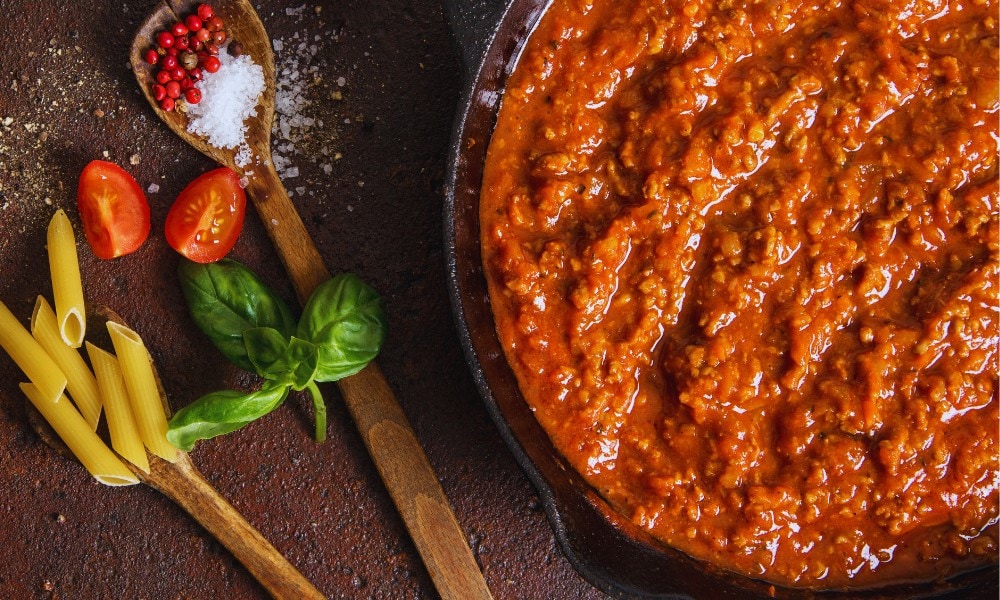
Pasta sauce may include diced veggies, or finely chopped carrots, onions, and celery, aka a mirepoix. Italian bolognese often contains red wine as a deglazing agent. But if you don’t want wine in your food, beef or chicken stock work just as well.
To take your sauce to the next level, try adding some of these flavor boosters:
- Crushed red pepper flakes
- Nutmeg
- Dried oregano
- Fresh basil
- Bay leaves
- Fresh parsley
- Garlic cloves
- Grated parmesan
As you can see, with pasta sauce, the sky’s the limit when it comes to creativity in the kitchen. To see how three different chefs with different skills make theirs, check out this video:
Be sure to check out our Spaghetti Bolognese recipe and give it a try!
Can I Substitute Marinara Sauce for Pasta Sauce?
Yes, in most cases, you can substitute marinara for pasta sauce. While the two sauces have slightly different flavor profiles, they both share tomato as a core ingredient.
Marinara is often used as a pasta condiment for dishes like spaghetti, lasagna, or baked ziti. It’s also a favorite dipping sauce in the US.
How Do You Thicken Marinara and Pasta Sauce?
A plate of Italian pasta with a watery, runny red sauce can be an unappetizing sight! Here are a few common methods to make your tomato sauces thicker.
- Simmer longer: Many home cooks don’t realize how much time it takes to properly reduce a pasta sauce! You need to wait until 90 percent of the water in a raw tomato evaporates. Depending on your tomatoes and batch size, that takes 30-90 minutes. Stir the sauce frequently to prevent it from sticking to the bottom of the pot and burning.
- Add a thickener: Thickening agents, such as cornstarch, flour, or a roux (a mixture of flour and fat), absorb the moisture and quickly thicken the sauce. But you can’t directly add the powder to the sauce. Instead, create a slurry by mixing the thickener with some water. Then add the slurry to the sauce and stir.
- Use tomato paste: Tomato paste is a thick, concentrated tomato sauce with a rich flavor. You can add it to your marinara or spaghetti sauce to enhance the consistency. Simply add a tablespoon or two of paste to the sauce and stir until it is fully incorporated. And if you want to add a bright red color to your sauce, fry the paste in some oil for one minute before incorporating it into your sauce.
- Add cheese: Adding cheese can thicken your sauce, but it can also affect the overall flavor, particularly if you’re making a classic marinara sauce, which doesn’t include cheese.
- Puree the sauce: Pureeing the sauce with an immersion blender breaks down any large chunks of tomato and creates a smoother, thicker texture.
Can You Use Marinara Sauce for Pizza?
Pizza sauce typically refers to the classic Margherita sauce from Italian cuisine, which includes tomatoes and basil and is topped with mozzarella. It’s a savory sauce known for its bold, robust flavor. Depending on the recipe, pizza sauce can contain garlic, onions, oregano, thyme, red pepper flakes, and black pepper.
But you can use marinara sauce for homemade pizza! Make sure the sauce has a thinner consistency than what you’d use for spaghetti and meatballs – unless you top it thoroughly with cheese. A thicker pizza sauce that’s exposed to the oven will dry out and burn, leaving you with a dry, unappetizing result. You can thin out the marinara sauce by adding a little bit of water or tomato juice.
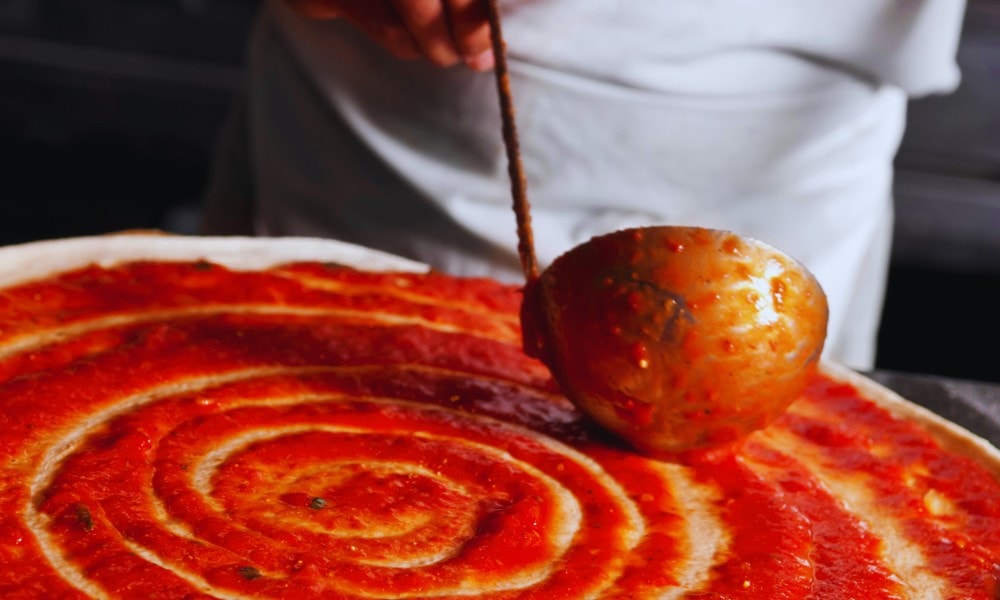
To ensure your marinara sauce gets evenly spread on the dough, pulse it with an immersion blender until it becomes smooth. This will eliminate any lumps or chunks in the sauce and create a more consistent texture.
Spread a thin layer of the sauce over the pizza bread, leaving a little space around the edges. This way, your pizza won’t get soggy, and you’ll get a crispy crust.
Are Marinara and Pomodoro Sauce the Same?
Pomodoro is the simplest type of tomato sauce, lighter even than marinara.
Although you need onions, garlic, and basil for pomodoro, these ingredients aren’t part of the finished sauce. They’re only there to add flavor while the base simmers and reduces. Once the sauce is ready, they come out. To make Pomodoro, you chop the ingredients into large chunks so they’re easier to extract once the sauce is ready.
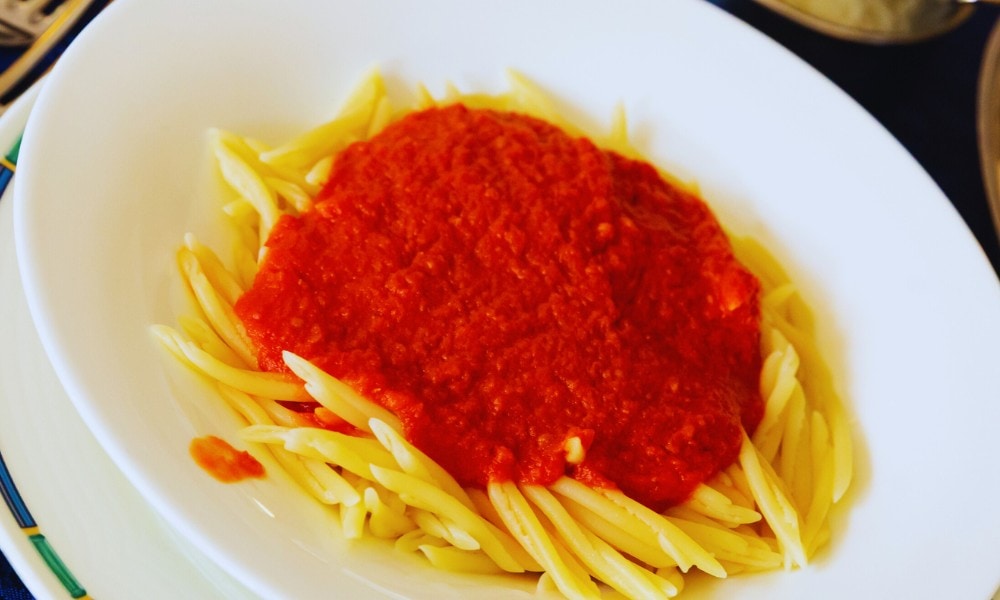
Some cooks also like to add carrots, celery, and a piece of parmesan rind to the base.
In contrast, the extra ingredients remain a part of the marinara after cooking. Onions and garlic are finely chopped and sauteed in olive oil before pouring in the tomatoes, and the basil comes in at the end. Moreover, marinara doesn’t include any cheese.
Here’s a quick comparison of marinara and other common sauces:
| Sauce | Ingredients | Texture | Flavor | Usage |
|---|---|---|---|---|
| Marinara Sauce | Tomatoes, garlic, onions, herbs | Smooth or slightly chunky | Tangy, slightly sweet | Base for pasta dishes or a dipping sauce for breadsticks |
| Pomodoro Sauce | Tomatoes, garlic, onions, basil, carrots, parmesan | Smooth | Sweet and tangy | Basic tomato sauce for pasta dishes |
| Pizza Sauce | Tomatoes, garlic, herbs | Smooth | Tangy, slightly sweet | Base for pizza |
| Margherita Sauce | Tomatoes, garlic, basil, mozzarella | Smooth | Fresh, slightly sweet | Base for Margherita pizza |
| Pasta Sauce | Tomatoes, garlic, onions, herbs, meat, cream | Thick and chunky | Savory, slightly sweet | Topping for pasta dishes |
| Bolognese Sauce | Tomatoes, ground beef, garlic, onions, celery, carrots, herbs, wine | Thick and chunky | Savory, meaty, and slightly sweet | Topping for pasta dishes |
| Alfredo Sauce | Butter, cream, parmesan | Thick and creamy | Rich, buttery, and cheesy | Sauce for pasta dishes |
Frequently Asked Questions
Does Marinara Sauce Go Bad?
You can refrigerate marinara in a sealed glass jar for up to five days. However, the duration can vary depending on the ingredients in the sauce. For example, fresh basil wilts and spoils quickly.
To extend your marinara’s shelf life, you can prepare the tomato component and add the fresh basil before serving your dish. Alternatively, you can freeze the sauce, but the fresh herbs will still turn out wilted and dark.
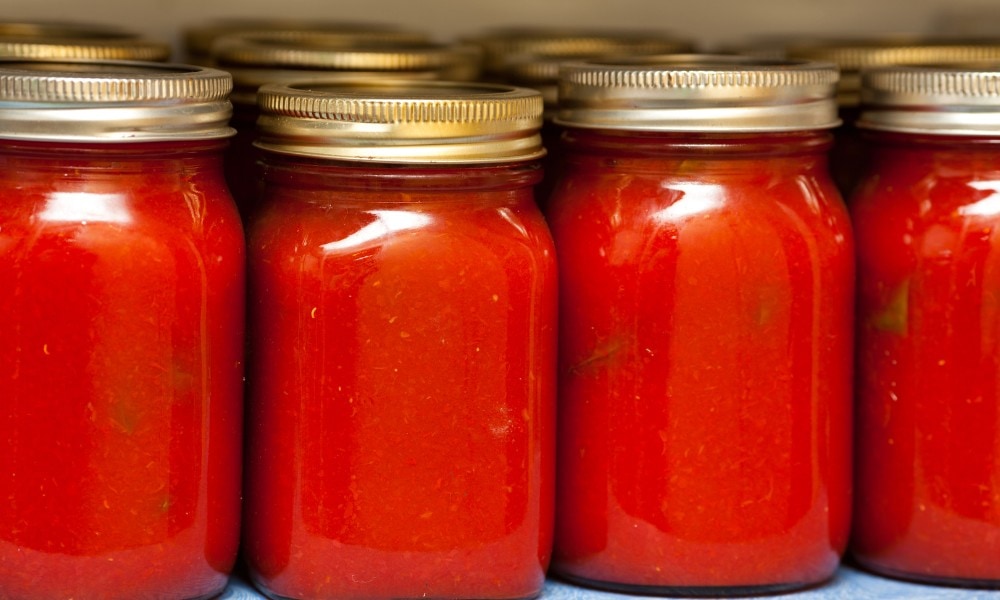
Does Pasta Sauce Go Bad?
Pasta sauce can spoil if it isn’t stored properly or kept outside the fridge for too long. The sauce has an extra high risk of spoiling if it contains meat and dairy products. The homemade version doesn’t last longer than three days in the fridge, while canned products can last for up to a week after being opened if kept below 40 degrees Fahrenheit.
You can also freeze the sauce in an airtight container or freezer bag. Frozen pasta sauce can last for several months. Before using the sauce, thaw it in the refrigerator overnight and then heat it thoroughly before serving.
Can You Freeze Tomato Sauce?
You can definitely freeze tomato-based sauces, such as Pomodoro or marinara. However, the texture may change slightly once it’s thawed because the water separates from the other ingredients. Adding a small amount of olive oil and then blending it may help the sauce emulsify and improve the texture.
To freeze homemade tomato sauce, let it cool completely first. Then, transfer the sauce to an airtight plastic container or freezer bag, leaving some room at the top for expansion. Be sure to label the container with the date and contents.

Final Thoughts
Pasta sauce and marinara may seem similar at first, but they have different ingredients, consistency, and usage.
Marinara is a lighter sauce with a tomato flavor, but pasta sauce is a richer, chunkier sauce that often contains meat, cheese, or wine. While these sauces are interchangeable in some recipes, marinara is more versatile. It can be used for dipping, on pizza, and over spaghetti.
If you have any questions or comments, please feel free to leave them below.

